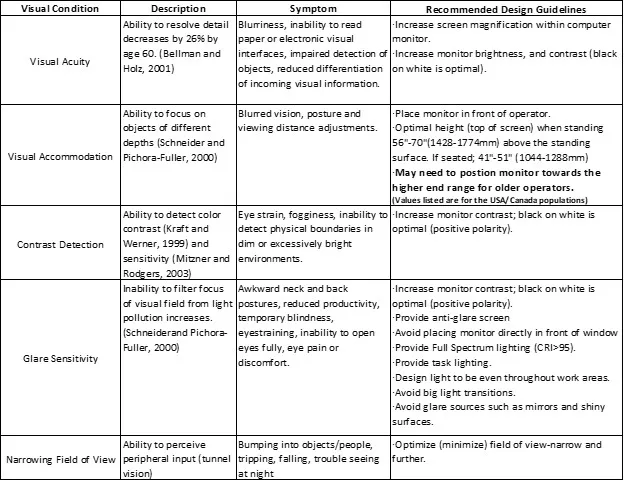As the human lifespan continues to lengthen, people are remaining in the workforce longer. Individuals who are working at 40 years of age and older are categorized as the “aging workforce population.” According to the Bureau of Labor Statistics in 2021, one in four of American workers was 55 years of age or older. With the steady increase of the aging workforce population, it is important to be aware of the possible physiological challenges that may arise within this population.
Gradual physiological challenges within the aging workforce to be aware of are changes with one’s vision, hearing, strength, and range of motion. This blog will specify the possible visual challenges faced and the recommended ergonomic design guidelines for enhancing the capabilities of the aging workforce, which will ultimately benefit employees of all ages.
Visual Challenges of the Aging Workforce
As we all know, our vision decreases with age, and the detrimental impact of these changes on employees can be significant. As these changes manifest, workers are forced to cope with previously benign aspects of typical work environments. This is something that safety professionals should consider when designing a work environment that can fit all workers.
Substantial visual changes to expect include reduced visual acuity (ability to resolve detail), contrast detection (ability to distinguish differences in color), accommodation (depth perception), and field of view. Failure to recognize the need for changing the workplace environment may result in not only a decrease in performance but may cause additional risk of workplace musculoskeletal disorders, as some visual challenges can create awkward body postures just to have a better line of sight of the work being performed.
Recommended Ergonomic Design Guidelines
The visual design guidelines below are provided to aid ergonomists and other safety professionals in designing the workplace for the aging workforce population and will serve as a strong foundation for future design considerations.

References:
- Bellmann, C. and Holz, F. “Visual Impairment and Functional Deficits in Age-related Macular Degeneration,” On the Special Needs of Blind and Low-Vision Seniors, H. Wahl and H. Schulze, eds., IOS Press, Amsterdam, 2001, pp. 49-57
- BLS Labor Force Statistics from the Current Population Survey, 2021, https://www.bls.gov/cps/cps_aa2021.htm
- Health Promotion / Wellness / Psychosocial-Aging Workers, June, 2022, https://www.ccohs.ca/oshanswers/psychosocial/aging_workers.html
- Kraft, J. and Werner, J., “Aging and the Saturation of Colors, 1: Colorimetric Purity Discrimination,” Journal of the Optical Society of America A, Vol. 16, No. 2, February 1999, pp. 223-230.
- Mitzner, T. and Rogers, W., “Age-Related Effects of Reading Text Presented with Degraded Contrast,” Proceedings of the Human Factors and Ergonomics Society 46th Annual Meeting, Human Factors and Ergonomics Society, Denver, CO, October 2003.
- Schneider, B. and Pichora-Fuller, M., “Implications of Sensory Deficits for Cognitive Aging,” The Handbook of Aging and Cognition, 2nd ed., F. Craik and T. Salthouse, eds., Lawrence Erlbaum Associates, Mahwah, NJ, 2000, pp. 155-219.
